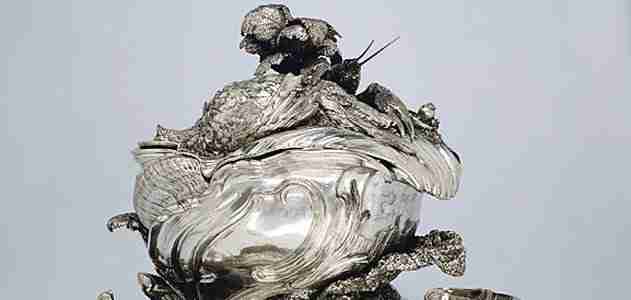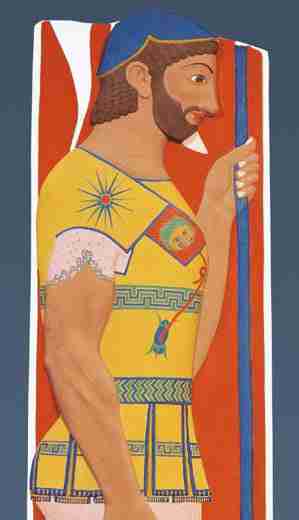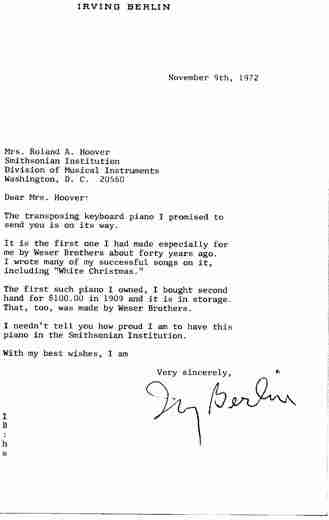Curves Ahead

Among his collections of birds' nests, seashells and gnarled sticks in artist Ted Muehling's Manhattan studio is a white porcelain sea horse crafted from an 18th-century mold. With its curling tail and grinning teeth, the creature is sensuous and playful; it is Rococo at its finest.
"You can tell people were having fun," Muehling says. Though the designer is known for his minimalist jewelry, he has lately been drawing on Rococo's lighthearted shapes for inspiration. "There's a tendency for people to head toward Rococo now," he says, "because minimalism has hit the wall."
That's the idea behind a new exhibition at the Cooper-Hewitt, National Design Museum—"Rococo: The Continuing Curve, 1730-2008," through July 6. "I was aware that many contemporary designers were experimenting with Rococo forms as a way out of modernism," says curator Gail S. Davidson. She says she sees this exhibit as a way to get "people interested in Rococo through the back door, so to speak." Based on natural forms like water and seashells, Rococo emerged during the reign of French King Louis XV (1710-1774)—a deliberate reaction to the stiff, symmetrical designs popular under his predecessor, Louis XIV. A book featuring the designs of silversmith Juste-Aurèle Meissonnier, published circa 1748, helped spread the style throughout Europe and to America. A Meissonnier silver tureen, a highlight of the Cooper-Hewitt show, epitomizes the style's exuberance, with its curling leaves and vegetables, crowned with a crayfish and a partridge.
"I completely fell in love with his designs," says Muehling, who was inspired by Meissonnier when he created his 2003 "branch candlesticks," one of which is included in the exhibition. The pieces, made at a Munich porcelain factory that has been in operation since 1747, were cast from wind-twisted cedar sticks.
Muehling and other contemporary artists whose works are in the exhibition can be said to be rebelling against 20th-century modernism, as typified by Ludwig Mies van der Rohe's "Barcelona Chair" or the paintings of Piet Mondrian. With its disciplined lines, modernism rejected ornamentation and focused on simplicity and practicality. Or, as Davidson puts it, "modernism had no sense of humor."
Though Muehling is a long way from the 18th century, he shares the aspirations of that era's craftsmen, who sought to transform functional objects into art. "Design can enhance something as small as drinking a glass of water," he says. To that end, one of his next projects is an elaborate chandelier. Pointing out a prototype made of cheap plates screwed together, he says he envisions tiers overflowing with porcelain gods and goddesses, with animals peering down over the edges. Like the crayfish and partridge on Meissonnier's silver tureen, their only purpose will be to delight.

Forensic Science for Antiques

The clients had paid many thousands of dollars for the Chinese silk samples with the bird motifs and now wanted reassurance that they were indeed from the Warring States period (about 480–221 B.C.).
But the news was not good. After testing them, the Rafter Radiocarbon Laboratory in New Zealand declared the samples less than 50 years old. "We had some really unhappy submitters," says Dr. Christine Prior, team leader at Rafter, which is part of the National Isotope Centre of the Institute of Geological and Nuclear Sciences.
We've all marveled at the forensic wizardry that traps villains on such TV hits as CBS's "CSI" ("Crime Scene Investigation"), but dazzling science is also exposing secrets in another, more refined field—art. Armed with the latest technology, art historians are becoming cultural detectives, piecing together the puzzle of an item's past and, in the process, helping differentiate genuine from bogus.
The fake Chinese silk samples fell afoul of radiocarbon dating, a technique discovered in 1949 but greatly improved since then. It can tell the age of material (such as wood, silk, cotton or bone) that was alive in the last 50,000 or so years by measuring the amount of carbon 14 it has lost. Dr. Prior says that the period 1650 to 1950 is hard to date precisely because so much fossil fuel (oil and coal) was burned that it "disturbed the natural production cycle of carbon 14." However, nuclear tests conducted in the 1950s and 1960s released huge quantities of carbon 14 in the air, creating the "bomb effect"—a chronological benchmark.
"Although art and antiquities forgers can be very exact in replicating materials, style and technique," she explains, "if they use a raw material that has been growing since 1950, it will have 'bomb' carbon 14 in it."
Radiocarbon dating and other high-tech tools have become such adjuncts to art collecting that many museums and art galleries have extensive in-house laboratories. Wondering about the age of an oak panel painting from northern Europe? Dendrochronology can reveal when the tree was felled by counting the number of rings in the wood. Trying to date an Italian bronze? X-ray fluorescence (XRF) spectroscopes detail the metal's composition, thereby providing the alloy mix that is characteristic of a certain period. And if the item is too large to bring to a lab, portable XRF machines provide in situ inspection. Could this be a newly discovered Monet? Pigment analysis will tell whether the paints used were available during Monet's lifetime. Infrared reflectography, ultraviolet light, plain old X-rays, CT scans and microscopes are all part of the exploratory process.


Nicholas Penny, the new director of the National Gallery in London and former senior curator of sculpture at the National Gallery of Art in Washington, D.C., says: "A very great deal of the investigation is undertaken to find out how an item was made, not necessarily to clear it for authentication."
But authentication is an overwhelming issue, especially when it comes to Chinese items. Soaring auction prices—Christie's sold a Yuan Dynasty (mid-14th century) blue and white porcelain jar for $27.7 million in 2005—combined with China's tradition of reproduction have proved a dangerous mix, leading to a flood of forgeries. Almost 75 percent of the so-called antiques marketed through Hong Kong are said to be copies. That's where another state-of-the-art technique comes in: thermoluminescence (TL) dating. Small samples taken from inconspicuous parts of the object are heated to a sufficiently high temperature to produce a measurable blue light (thermoluminescence). Pottery, porcelain and the casting cores of bronzes can be dated by the amount of radiation the piece absorbs. The more intense the glow, the older the piece.
"Our conclusions are based purely on measurement and not on databases or 'expert' opinion," says physicist Doreen Stoneham, director of Britain's Oxford Authentication Ltd., which tests between 3,000 and 3,500 items a year, 90 percent of them Chinese. With a client base of almost 2,000, including the most prestigious museums and art galleries in the world, plus 50 representatives authorized to take samples in 12 countries, the laboratory is the gold standard in TL testing. Its certificates are so desirable that, ironically, they too have been victims of forgery.
To outsmart TL, forgers artificially irradiate items, re-work old clay, mix and match parts from several objects or glaze the phony areas, forcing the test to be done on a genuine section. Oxford assures its test is plus or minus within 20 percent accurate of the date the piece was fired, but sometimes an item is fired more than once, making the dating less reliable.
"The only way to reduce the risk of deceptive results," says Dr. Stoneham, "is to use several techniques in conjunction, to examine different aspects of the object."
And don't forget that old standby—the individual.
"The human element comes in interpreting the results of the tests," says Dr. Penny. "To say that all these methods are available doesn't mean that all are being applied. Sometimes the overwhelming evidence is such that this is not needed."
Small House Museums

London Sir John Soane's Museum is at 13 Lincoln's Inn Fields, not far from the Holborn tube station. It is open Tuesday-Saturday, 10 a to 5 Telephone: 011-44-20-7440 4240 Web site: www.soanerg .
The candlelit nights are on the first Tuesday of the month from 6 to 9 ; queues form early, so arrive as early as possible. Entrance is free, but groups of more than six people must book in advance. Commercial groups are requested to make a $97 donation. An excellent follow-up to Soane's is a visit to the Hunterian Museum across Lincoln's Inn Fields in the Royal College of Surgeons; its halls are filled with medical specimens, giant skeletons and vintage surgical instruments. London's other great 19th-century survivors are the Wallace Collection, housed in the Hertford House, and the palatial Royal Academy of Arts, where as Professor of Architecture from 1806 to 1837, Soane gave a series of famous lectures.
Paris The Musée Jacquemart-André is located at 158 Boulevard Haussmann, near Place Charles de Gaulle-Étoile and Metro stations: Saint-Augustin, Miromesnil, and Saint-Philippe du Roule. It is open every day from 10 a to 6 The $15.50 admission fee includes a free English audioguide, which is surprisingly good. (It includes fun extras, such as chamber music to listen to in the Music Room). Web site: usee-jacquemart-andreom (in French)
Madrid The Museo Sorolla lies only a ten-minute taxi ride from the city center, in the Chamberí district, at Paseo del General Martínez Campos 37. It is open 9.30 a to 3 Tuesday-Saturday, 10 a to 3 Sunday, and closed Mondays. Entrance fee: $3.70, $1.85 for seniors and students. Telephone: 011-34-91-310-1584 Web site: museosorollacus (in Spanish) Website: translated to English
Prague The Black Madonna House: The Museum of Czech Cubism is in the Old Town of Prague at Celetna Street, 34 and Ovocny 19. It is open daily except Mondays, 10 a to 6 Entrance fee: $6.25. Telephone: 011-420-222-321-459 Web site: gprague
The Grand Café Orient is open from 10 a to 10 Tel: 011-420-224-224-240. The museum store sells an excellent fold-out map that tracks other Cubist architecture in Prague. True enthusiasts should head to the Veletrzní Palace (Dukelskych hrdinu 47), a vast museum of 19th-, 20th- and 21st-century art that includes detailed surveys of Czech trends. The most striking literary counterpart is the long-term exhibit at the Franz Kafka Museum (Hergetova Cihelna, Cihelná 2b; open daily, 10 a to 6 This is less a traditional museum than a creative interpretation of Kafka's life and work, divided into two sections, "Existential Space" and "Imaginary Topography of Prague," that feature art installations, film, music and photography. History fans should also make time to visit the Cabinet of Curiosities at the Strahov Monastery, where glass-fronted cases display a fascinating array of sea creatures; the twin libraries in the same building are among Europe's most gorgeous.




Post a Comment